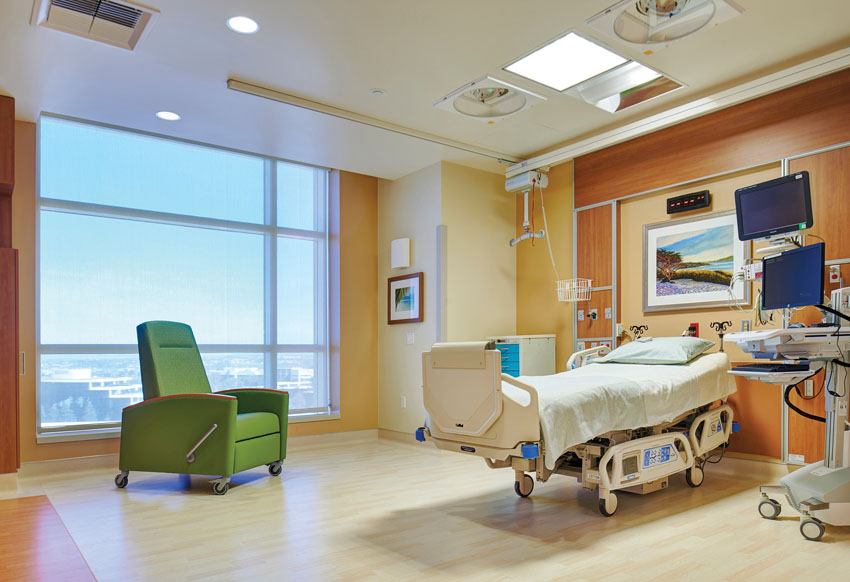Healing Environments for Health Care
Learning Objectives:
- Identify and recognize the significance of good restroom design, including plumbing fixtures, storage, and showers as a means to provide positive health-care experiences.
- Assess the health and safety performance aspects of wall and floor surfaces as they relate to durability and sustainability.
- Explain the importance of proper attention to details related to accessibility for the safety and well-being of wheelchair-bound persons.
- Determine ways to incorporate principles presented into buildings as shown in case studies.
Credits:
This course is approved as a Structured Course
This course can be self-reported to the AANB, as per their CE Guidelines
Approved for structured learning
Approved for Core Learning
This course can be self-reported to the NLAA
Course may qualify for Learning Hours with NWTAA
Course eligible for OAA Learning Hours
This course is approved as a core course
This course can be self-reported for Learning Units to the Architectural Institute of British Columbia
Health-care facilities of many different types continue to drive a lot of design and construction activity. Some are responding to the burgeoning needs of aging baby boomers, while others are focused on ways to provide a better health-care experience. Hospitals and other in-patient facilities, for example, are trending toward providing private suites, with rooms looking more like hotel rather than institutional settings. This seems to be driven by a goal of creating outstanding patient experiences, adding to the perceived value and overall satisfaction provided by the facility, which helps with competition from other options in a geographic area. There is also a definitive trend toward providing medical treatments and surgical follow-ups in outpatient-care facilities, where overnight stays are not required. Nonetheless, outpatient-care facilities need to be designed and built to the same standards as hospitals, have the same appealing environments for patients, and be built affordably. Recognizing the need to balance high standards of care, hygiene, and functionality for health-care personnel with the comfort and overall experience of the patient, this course looks at some techniques and approaches to address this. Specifically, it will cover different aspects of health-care design that can be used to enhance all types of facilities.

Photo courtesy of Lonseal
Health-care designs are increasingly focused on improved patient experiences while still meeting the clinical needs of care providers.
WELL-DESIGNED RESTROOMS
All people, whether patients, care providers, or visitors, will likely need a restroom during their time in a health-care facility. So, whether designers realize it or not, this is one of the rooms that can make a widespread impression on everyone, and that impression can be either a positive or negative one. While restrooms need to be designed around good hygiene, that doesn’t mean they need to look sterile and cold. Rather, consistent with the general trend of making health-care facilities look more welcoming, restrooms in health-care settings are being designed to look and feel more comfortable. At the same time, attention is being paid to ways to limit the spread of germs and bacteria. A number of products and design approaches that meet these criteria are discussed in the following sections.
Plumbing Product Options
Since all restrooms are designed around the plumbing fixtures, that is the best place to start to keep things positive. To help with that, it is important to recognize that there are commercial plumbing products currently available that offer unique solutions specifically for all kinds of health-care facilities with all types of users. Manufacturers of commercial plumbing products recognize that there are different needs for different parts of a hospital or other health-care facilities. Therefore, they offer a wide range of products for design professionals to choose from to match the best selection with the specific needs of a facility. From a functional standpoint, that includes, for example, plumbing products well suited to meet the particular needs of patients requiring special care. For less-specialized locations, there are other commercial plumbing products very suitable for access by the general public or for staff areas, such as nurse’s stations, etc.

Photos courtesy of Kohler Co.
Well-designed restrooms in health-care settings can help provide both a positive impression and experience for patients, care providers, and visitors.
Commercial plumbing manufacturers also respond to design trends in the creation of their products. Along that line, it is worth recognizing that there are choices available that offer a less-institutional look and more of a familiar residential appearance, even though they are in fact heavier-duty commercial fixtures. This fits right in line with the trend of helping patients feel more comfortable and “at home” when needing to spend time in an otherwise institutional setting of a hospital or outpatient center.
Due to their typically high use, toilets in particular are subject to needing replacement over time in health-care buildings. Such replacement can be part of either a general renovation project or the regular operations and maintenance of the facility. One of the common issues with such toilet replacements is related to the fact that health-care facilities have bariatric and geriatric patients, for example, that require more support than a wall mount is capable of providing. It is a trend for facilities to move to a floor-mount bowl to offer more support. Normally, this replacement from a wall- to floor-mount toilet requires extended renovation scheduling. The added time and complexity of this situation adds cost, not just for the material and labor needed, but also for the possibility of lost room revenue during the work.
At least one manufacturer has addressed this renovation issue by offering a rather revolutionary retrofit solution. Instead of a wall-bowl toilet, it has designed a floor-mount bowl that does not require any work behind the wall during a replacement. This takes what would normally be several days of work and thousands of dollars in material, labor, and lost room revenue ($5,000–$20,000 estimates) down to only less than 1 hour in labor time and less than $1,000 in cost. This type of commercial toilet was strategically designed for health care based on specific requests from health-care facility personnel to be able to provide these wall-to-floor renovations.
There are other innovations that manufacturers are incorporating into toilets for healthcare facilities. These include having options for bed-pan lugs in the toilet bowls to help secure or position a bed pan to collect samples or dispose of waste and clean the bed pan. Manufacturers also offer antimicrobial finishes that inhibit the growth of mold-, mildew-, stain-, and odor-causing bacteria on the fixture surface. (The standard disclaimer on these is that an antimicrobial agent does not protect the user from disease-causing bacteria.)

Photos courtesy of Kohler Co.
Innovative commercial plumbing products are available for health-care set-tings that make renovations easier and provide better touchless controls.
Touchless Operation
All health-care environments must maintain certain infection-control standards, particularly when it comes to the transfer of bacteria andother contagions. Another way to address hygiene concerns in restrooms is to use “touchless” technology wherever possible, such as faucet handles and toilet levers. Toward that end, a series of touchless options are available to use in these situations.
Touchless flush sensors have been used on toilets and urinals for some time; however, they may not be the best choice in a health-care setting. For example, a care taker helping someone on and off a toilet can unintentionally trigger multiple flushes, which can be disconcerting or problematic for many patients. A better solution is to install a manual, touchless flushometer to actuate the flush by waving a hand over the sensor. This restores control back to those using it by not flushing until the time is appropriate. And since it is fully touchless, it still provides the needed safety and hygiene.
For faucets, there are commercial touchless products that provide the same type of sensor technology to minimize the spread of bacteria by allowing users to start and stop the flow of water by waving their hands instead of touching the product. Equally important for hygiene is the selection of faucets that will not spread airborne or waterborne pathogens. It is critical to select faucets with laminar flows so there is no chance to aerate the water and introduce airborne pathogens into the water. Conversely, it is important to not select rose-spray faucets, as they can aerosolize the water and introduce waterborne pathogens into the air. Waterborne and airborne concerns are as significant as direct transfer on surfaces, so addressing all of these in a single product makes inherent sense. From a design standpoint, touchless faucets with a residential aesthetic help with the “feeling at home” experience sought in many cases, while still providing products made for commercial environments.
Environmental Friendliness
Any products that use water have an environmental impact during consumer use simply due to the consumption of this natural resource. The water use also requires energy for pumping, purifying, and treating it after use, so reducing the amount of water used can be a significant benefit for the environmental impact. Commercial plumbing products that require less water for each use are therefore preferable, and faucet or flush controls that do not use excess water are best.
Many of the sensors in the plumbing fixtures we have discussed require some electricity to operate. That may mean running electrical wiring and can force a compromise in the case of a power outage. Some products may use regenerative recharging of a battery, such as a solar cell on top of the faucet (collecting energy from the lights in the restrooms) or hydro charging (using the water flow to generate electricity). These are all good but need to be investigated for their durability and longevity for trouble-free operation. At least one manufacturer provides another simpler option in the form of a 30-year battery (875,000 cycles) that provides uninterruptable power and is maintenance free.
Overall, higher-level technology is being incorporated into commercial plumbing products for health-care use to assure ease of installation, long-term performance, quality, and ease of maintenance.
Notice

www.aamsco.com/mirrors/wheelchair-medicine-chest


www.inpro.com

www.kohler.com

www.lonseal.com

www.waclighting.com















